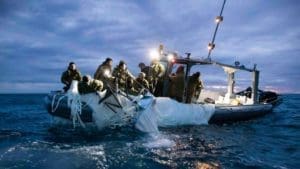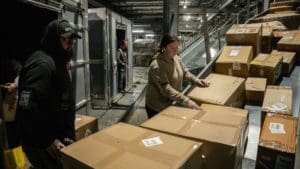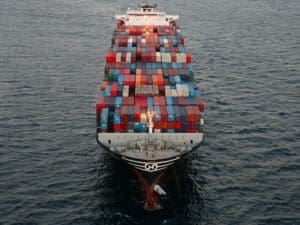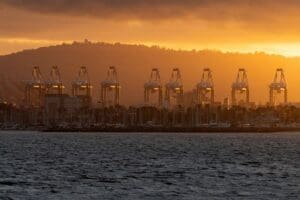 A big story earlier this month was the reported Chinese spy balloon. From January 28 to February 4, a Chinese-operated high-altitude balloon was seen in North American airspace, including Alaska, western Canada, and the contiguous United States. On February 4, the U.S. Air Force shot down the balloon over U.S. territorial waters off the coast of South Carolina. The American and Canadian militaries believe that the balloon was for surveillance, while the Chinese government said it was a civilian meteorological research airship that had blown off course. However, the flight path and structural characteristics made it dissimilar from those which have typically been used for meteorological research. Now that the U.S. military has retrieved the wreckage, new details are emerging. Last Friday, the Commerce Department named six Chinese enterprises as makers of balloon and airship equipment, which the agency alleged is connected to intelligence gathering by the People’s Liberation Army. The enterprises were added to a lengthy register of companies the U.S. aims to block from obtaining American high technology. China’s government has so far not commented on the new sanctions or on the news of the flying object, nor responded to questions. And now on to this week’s logistics news.
A big story earlier this month was the reported Chinese spy balloon. From January 28 to February 4, a Chinese-operated high-altitude balloon was seen in North American airspace, including Alaska, western Canada, and the contiguous United States. On February 4, the U.S. Air Force shot down the balloon over U.S. territorial waters off the coast of South Carolina. The American and Canadian militaries believe that the balloon was for surveillance, while the Chinese government said it was a civilian meteorological research airship that had blown off course. However, the flight path and structural characteristics made it dissimilar from those which have typically been used for meteorological research. Now that the U.S. military has retrieved the wreckage, new details are emerging. Last Friday, the Commerce Department named six Chinese enterprises as makers of balloon and airship equipment, which the agency alleged is connected to intelligence gathering by the People’s Liberation Army. The enterprises were added to a lengthy register of companies the U.S. aims to block from obtaining American high technology. China’s government has so far not commented on the new sanctions or on the news of the flying object, nor responded to questions. And now on to this week’s logistics news.
- UPS’ RFID initiative to expand to rest of US network in 2023
- Supply chain software firm Descartes acquires GroundCloud for $138M
- Retailers hope to bargain for lower ocean-freight rates
- Port of Long Beach container volume plops
- Grocers say sustainability is a key priority in 2023
- MIT, brands innovating ways to handle small plastics
- Aerospace suppliers face competition for hires from planemakers
 On an earnings call last week, UPS CEO Carol Tomé said the company plans to deploy its smart package initiative throughout the rest of its U.S. network this year after its initial success at select facilities in 2022. The initiative involves placing RFID tags on packages and wearable devices on employees to eliminate manual scans, reduce misloads, and accelerate parcel throughput in the delivery giant’s warehouses. Expanding the smart package initiative will help UPS strengthen its network efficiency as it seeks to reduce costs in a cooling demand environment. The smart package program also aims to improve the customer experience by slashing the rate of packages placed in the wrong delivery vehicle. UPS looks to reduce the frequency of misloads from one in 400 to one in 800 through the initiative with the potential for improvements beyond that. One hundred UPS facilities are currently participating. The company plans to invest $140 million in the initiative in 2023 as it implements the technology at its 940 remaining U.S. buildings.
On an earnings call last week, UPS CEO Carol Tomé said the company plans to deploy its smart package initiative throughout the rest of its U.S. network this year after its initial success at select facilities in 2022. The initiative involves placing RFID tags on packages and wearable devices on employees to eliminate manual scans, reduce misloads, and accelerate parcel throughput in the delivery giant’s warehouses. Expanding the smart package initiative will help UPS strengthen its network efficiency as it seeks to reduce costs in a cooling demand environment. The smart package program also aims to improve the customer experience by slashing the rate of packages placed in the wrong delivery vehicle. UPS looks to reduce the frequency of misloads from one in 400 to one in 800 through the initiative with the potential for improvements beyond that. One hundred UPS facilities are currently participating. The company plans to invest $140 million in the initiative in 2023 as it implements the technology at its 940 remaining U.S. buildings.
 Descartes Systems Group, a global leader in uniting logistics-intensive businesses in commerce, announced that it has acquired GroundCloud, the creator of a cloud-hosted final-mile automation platform, for $138 million. By acquiring GroundCloud, which was officially known as Windigo Logistics Inc., Descartes is aiming to improve its final-mile delivery capabilities, putting worker and community safety at the forefront of its efforts. GroundCloud cloud-hosted software platform combines operations, safety and compliance, and is used by final-mile carriers to receive customer delivery orders and plan and execute routes based on those orders. It also helps with training and monitoring delivery drivers in safety and performance, managing assets and resources, and analyzing the efficiency of logistics operations. In addition, as part of its mandate to improve safety, GroundCloud’s platform also incorporates video telematics for driving event detection and verification, enabling companies to leverage the insights it generates to inform reactive training programs.
Descartes Systems Group, a global leader in uniting logistics-intensive businesses in commerce, announced that it has acquired GroundCloud, the creator of a cloud-hosted final-mile automation platform, for $138 million. By acquiring GroundCloud, which was officially known as Windigo Logistics Inc., Descartes is aiming to improve its final-mile delivery capabilities, putting worker and community safety at the forefront of its efforts. GroundCloud cloud-hosted software platform combines operations, safety and compliance, and is used by final-mile carriers to receive customer delivery orders and plan and execute routes based on those orders. It also helps with training and monitoring delivery drivers in safety and performance, managing assets and resources, and analyzing the efficiency of logistics operations. In addition, as part of its mandate to improve safety, GroundCloud’s platform also incorporates video telematics for driving event detection and verification, enabling companies to leverage the insights it generates to inform reactive training programs.
 Retailers in the U.S. hope to slash shipping costs and save millions of dollars when they sit down later this month to negotiate long-term contracts with ocean carriers following last year’s surge in rates. Some companies expect to cut ocean-freight rates by half or more, which in turn could allow retailers to slow or stop price increases for goods. The average contract cost of shipping a container from China to the U.S. West Coast was $2,618 as of Feb. 9, according to Xeneta, a Norway-based transportation data firm, reflecting lower freight demand as retailers cut orders and consumer spending continues to decline. The rate rose to $8,607 on April 1, 2022, from $3,174 a year earlier. At the time, importers were desperate to secure space on ships for the summer and fall seasons and many signed contracts at double the previous year’s rates, according to shippers. Last year’s negotiations took place as dozens of container ships were backed up off the coast of California waiting to unload cargo. Shipping volumes had surged as consumers spent more on goods during the Covid-19 pandemic. A 20 percent increase in freight snarled supply chains because of a lack of space on docks and in warehouses as well as a shortage of truckers and trucking equipment.
Retailers in the U.S. hope to slash shipping costs and save millions of dollars when they sit down later this month to negotiate long-term contracts with ocean carriers following last year’s surge in rates. Some companies expect to cut ocean-freight rates by half or more, which in turn could allow retailers to slow or stop price increases for goods. The average contract cost of shipping a container from China to the U.S. West Coast was $2,618 as of Feb. 9, according to Xeneta, a Norway-based transportation data firm, reflecting lower freight demand as retailers cut orders and consumer spending continues to decline. The rate rose to $8,607 on April 1, 2022, from $3,174 a year earlier. At the time, importers were desperate to secure space on ships for the summer and fall seasons and many signed contracts at double the previous year’s rates, according to shippers. Last year’s negotiations took place as dozens of container ships were backed up off the coast of California waiting to unload cargo. Shipping volumes had surged as consumers spent more on goods during the Covid-19 pandemic. A 20 percent increase in freight snarled supply chains because of a lack of space on docks and in warehouses as well as a shortage of truckers and trucking equipment.
 The Port of Long Beach blamed shifts in consumer demand and shipping patterns for the 28.4 percent year-over-year drop in January container volume. The port moved 573,772 twenty-foot equivalent units in January. That’s down 28.4% from last year, which was the Port of Long Beach’s busiest January on record. January imports dropped 32.3 percent year over year to 263,394 TEUs and exports declined 14.2 percent to 105,623 TEUs. The number of empty containers moved decreased 29% to 204,755 TEUs, according to the latest statistics released by the port. “We are taking aggressive steps to meet a new set of challenges for the new year,” said Mario Cordero, executive director of the Southern California port, in a news release. “I remain optimistic that we will recapture market share and develop projects that will enhance our long-term growth, sustainable operations and the reliable movement of goods through the Port of Long Beach.”
The Port of Long Beach blamed shifts in consumer demand and shipping patterns for the 28.4 percent year-over-year drop in January container volume. The port moved 573,772 twenty-foot equivalent units in January. That’s down 28.4% from last year, which was the Port of Long Beach’s busiest January on record. January imports dropped 32.3 percent year over year to 263,394 TEUs and exports declined 14.2 percent to 105,623 TEUs. The number of empty containers moved decreased 29% to 204,755 TEUs, according to the latest statistics released by the port. “We are taking aggressive steps to meet a new set of challenges for the new year,” said Mario Cordero, executive director of the Southern California port, in a news release. “I remain optimistic that we will recapture market share and develop projects that will enhance our long-term growth, sustainable operations and the reliable movement of goods through the Port of Long Beach.”
 The booming shopper interest in sustainability is having a major influence on supermarket operating strategies. In its January survey of grocery executives and consumers, Grocery Doppio, a Jacksonville, Fla.-based research and insights firm, found that 71 percent grocers listed sustainability as a key priority for 2023; 76 percent see it as a C-level goal; and 43 percent said they have or will appoint a senior executive to lead their sustainability efforts in 2023. In addition, 83 percent of grocers cited waste reduction as their primary sustainability focus, followed by energy utilization (77 percent) and packaging improvement (66 percent). Many retailers have already responded to such interest with 61 percent of shoppers indicating that their preferred grocer has adopted sustainability practices in the last year and 23 percent said their preferred grocer does a good job in communicating their sustainability efforts.
The booming shopper interest in sustainability is having a major influence on supermarket operating strategies. In its January survey of grocery executives and consumers, Grocery Doppio, a Jacksonville, Fla.-based research and insights firm, found that 71 percent grocers listed sustainability as a key priority for 2023; 76 percent see it as a C-level goal; and 43 percent said they have or will appoint a senior executive to lead their sustainability efforts in 2023. In addition, 83 percent of grocers cited waste reduction as their primary sustainability focus, followed by energy utilization (77 percent) and packaging improvement (66 percent). Many retailers have already responded to such interest with 61 percent of shoppers indicating that their preferred grocer has adopted sustainability practices in the last year and 23 percent said their preferred grocer does a good job in communicating their sustainability efforts.
 Speaking of sustainability, five brands have partnered with a nonprofit and the Massachusetts Institute of Technology to find a way to keep small plastic items in the recycling stream. Colgate-Palmolive, Procter & Gamble, the Estée Lauder Companies, L’Oreal, and Haleon want to make their small format plastic products – those less than two inches long – compatible with MRF collection systems. The MIT Environmental Solutions Initiative and nonprofit The Sustainability Consortium are working on a prototype that could make this goal a reality. The companies want the solution to work with the products exactly as they’re currently manufactured, which means handling a wide range of resins and shapes. The prototype will ideally be developed into an inexpensive piece of sorting equipment that can be easily integrated into a MRF’s current technology. Jennifer Park, collective action manager at The Sustainability Consortium, told MIT News that the project is an example of pre-competitive collaboration and an interesting approach to brand sustainability goals.
Speaking of sustainability, five brands have partnered with a nonprofit and the Massachusetts Institute of Technology to find a way to keep small plastic items in the recycling stream. Colgate-Palmolive, Procter & Gamble, the Estée Lauder Companies, L’Oreal, and Haleon want to make their small format plastic products – those less than two inches long – compatible with MRF collection systems. The MIT Environmental Solutions Initiative and nonprofit The Sustainability Consortium are working on a prototype that could make this goal a reality. The companies want the solution to work with the products exactly as they’re currently manufactured, which means handling a wide range of resins and shapes. The prototype will ideally be developed into an inexpensive piece of sorting equipment that can be easily integrated into a MRF’s current technology. Jennifer Park, collective action manager at The Sustainability Consortium, told MIT News that the project is an example of pre-competitive collaboration and an interesting approach to brand sustainability goals.
 Aerospace suppliers are gearing up for a hiring spree in 2023 but could face stiff competition for skilled laborers, including from their top customers – planemakers Boeing and Airbus. The tight labor market is a key factor in the industry’s supply-chain shortages and could determine whether Boeing and Airbus meet near-term production goals, industry officials said. Executives at last week’s Pacific Northwest Aerospace Alliance conference, a gathering of top suppliers, expressed concern about replacing workers who left through layoffs or attrition during the height of the COVID-19 pandemic. Since the pandemic, the aerospace supply chain has been hobbled by shortages in castings and forgings — particularly for aircraft engines — as well as a recent scarcity in extrusions, or other molded parts that can have lead times of up to 80 weeks. And labor has been a key cause of these shortages and resulting bottlenecks.
Aerospace suppliers are gearing up for a hiring spree in 2023 but could face stiff competition for skilled laborers, including from their top customers – planemakers Boeing and Airbus. The tight labor market is a key factor in the industry’s supply-chain shortages and could determine whether Boeing and Airbus meet near-term production goals, industry officials said. Executives at last week’s Pacific Northwest Aerospace Alliance conference, a gathering of top suppliers, expressed concern about replacing workers who left through layoffs or attrition during the height of the COVID-19 pandemic. Since the pandemic, the aerospace supply chain has been hobbled by shortages in castings and forgings — particularly for aircraft engines — as well as a recent scarcity in extrusions, or other molded parts that can have lead times of up to 80 weeks. And labor has been a key cause of these shortages and resulting bottlenecks.
That’s all for this week. Enjoy the weekend, and the song of the week, 99 Luftballons by NENA.

















